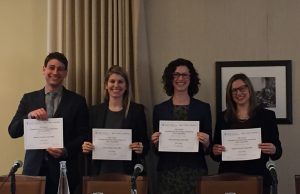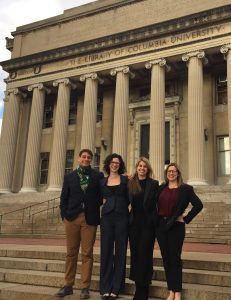By Reuben Goldstein, Reagan Richmond, Emily Robichaux and Nina Tschinkel
 This past Friday our Bard MBA team won first place at the Columbia University Energy Symposium Case Competition. It is an understatement to say we were surprised, but reflecting on the experience, it was truly the Bard difference that opened the door to victory.
This past Friday our Bard MBA team won first place at the Columbia University Energy Symposium Case Competition. It is an understatement to say we were surprised, but reflecting on the experience, it was truly the Bard difference that opened the door to victory.
We were a bit intimidated entering the competition. The prompt was a challenging case that asked us to evaluate the financial impacts of a potential partnership to launch a virtual power plant. We’d have to present our implementation and rate structure recommendation to our CEO (in the first round) and to the Public Utility Commission (in the second).

In addition to the challenging case, we knew we would compete with interdisciplinary teams from Yale, MIT, Columbia, NYU Stern, and more.
The case was full of metrics, including renewable energy standards, peak demand capacity needs, customer rates, and internal goals. We had a significant amount of data but also an incomplete picture of certain critical costs and customer breakdowns.
It was easy to get frustrated and, at several points while we were building our first model, we were tempted to just throw in the towel. But then we remembered one of our “Bard difference” lessons around data. In our Data and Analytics class, faculty member JD Capuano taught us to tell a story with the data—and to connect our data story to the larger organizational goals.
In order to tell the story of how our nameless utility would use a new technology to meet its long-term goals, we turned to a trusty session of storyboarding. Professor Laura Gitman’s lessons from NYCLab resounded in our heads as we debated our Statement-Complication-Problem and drew up our pyramid. More than once we exclaimed, “This is not MECE!”
When it came to evaluating the project’s stakeholders, the work from our Strategy and Marketing classes helped us quickly identify who and what was material to the success of our hypothetical pilot. And so, through many hours, our two presentation decks took shape and our financial model coalesced.
The financial model came together, but the NPV begged for heavy ratepayer subsidies: negative $4 million is a hefty price tag. In a moment of ethical clarity, we chose to forego Enron-style “creative accounting” and move forward with our expensive yet ultimately valuable project.
This is where we really put the Bard difference to work. Could we make a strong case for this project not on the merits of short-term financial gain, but as a valuable project that was the right first step toward helping our utility test a new business model critical for its long-term success?
After many hours of meetings, Google hangouts and spreadsheets, it was time to present. During check-in, we met the other teams—who were as brilliant, well-dressed and intimidating as we expected.
We used every spare moment to practice our presentation. And then we were off to meet with our CEO panel of judges. Hunter Lovins’ voice was in the back of our heads, reminding us to get comfortable with the room and clicker, have back-up notes, and not to call the lectern a podium. We nailed it! Or at least it felt that way when we walked out of the room.
In the break before the finalists were announced, we practiced our second presentation to the Public Utility Commission. In a moment of true insight, Reuben proposed that we structure our discussion around equity, highlighting access to renewable energy and impacts on ratepayers. We had a slide about equity but would need to ad lib critical points about increasing access and making our customers partners in developing distributed energy resources.
We were so deep in discussion and practice that we missed the announcement of which teams had advanced. Concerned (and a little disappointed), we made our way back to the symposium to pick up feedback sheets . . . only to learn to we had advanced!
Now the heat was on. We squeezed in one more run-through before re-entering the symposium to watch the other teams present. In the first round, we could not watch other teams compete, so we could only imagine the kinds of in-depth quantitative analysis they were presenting. This time, they were as strong as we imagined. Using Monte-Carlo simulations and Black-Scholes models, their quantitative skills were impressive.

It was late, the judges were tired and, admittedly, so were we. But after 30 seconds of power posing (chest up, hands on our hips), we took to the stage and delivered a powerful presentation. We spoke about our utility’s vision (to become a leader in developing a new business model) and values (environmental responsibility, equity, innovation) and how the mission of our organization and the PUC brought us to decide to launch a pilot VPP.
Ultimately, the Bard difference was our advantage. While we couldn’t “brute strength” our way through the quantitative analysis, we understood how to look at a challenge holistically, apply a sound problem-solving process, and tell a great sustainability story about leadership and investing in innovation.
Our pitch was realistic, and we received feedback that we “knew our audience” in a way not reflected by our competitors. Both are outgrowths of a focus on the integrated bottom line—that there is a way to conduct business that is good for people, planet, and profit in the long run, and that this mission resonates with stakeholders.
We are all grateful for this brief but intense experience (the timeline from receipt of case to presentation was less than two weeks). The process of forming a team (including team members who had never worked together before), of getting everyone up to speed (two of us had prior experience in the energy sector, while two had never heard of a virtual power plant), of struggling with the numbers and the value proposition, and of forming a cohesive presenting group was invaluable.
We applied what we had studied in our classes while learning to communicate within a new group, sharing leadership responsibilities, and feeling the pressure of deadlines and other time commitments, not unlike the real world. Having such a positive, intellectually challenging, and exciting team experience was the real prize—although winning first place in the competition certainly didn’t hurt!
3 thoughts on “Bard MBA Team for the Win: How the “Bard Difference” Made the Difference”
So proud of our Bard team!
A true testament to an integrated approach. Considering a broad range of stakeholders, telling a story based on data and metrics, and looking to the long view were all part of the success. But the crucial component was the team your commitment and confidence. Congratulations to all of you
Nice work, team Bard!